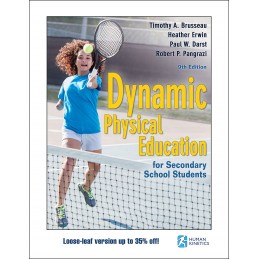Dynamic Physical Education for Secondary School Students (DPE) has been the go-to textbook for preparing future secondary physical educators for more than 30 years. Now in its ninth edition, this trusted resource has been thoroughly updated to maintain its high quality and continue to meet the needs of preservice and in-service teachers in developing curricula that meet SHAPE America physical education standards and grade-level outcomes.
DPE offers the best of both worlds:: in-depth explorations of critical concepts to provide readers the foundational knowledge they need to teach quality physical education, combined with a host of ready-to-use activities. The result is a resource that will help preservice physical educators feel confident in the class setting from day one.
Doctors Timothy Brusseau and Heather Erwin, coauthors for the previous edition, have taken the helm as lead authors this time. Improvements to this new edition include the following::
- Reorganized chapters that provide a clear, comprehensive description of effective secondary physical education
- New chapters on supporting and advocating for physical education (including budgeting, fundraising, facilities and equipment, communicating with stakeholders, professional development, and more) and on developing a comprehensive school physical activity program (CSPAP)
- Updated chapters on assessment and teaching students with disabilities
- The Dynamic PE ASAP website, which gives teachers access to examples of ready-to-use activities and complete lesson plans, as well as the ability to build their own lesson plans from the provided activities
DPE will help current and future educators learn how to promote physical activity throughout the school day and beyond, and they will be able to rely on a vast array of evidence-based activities and instructional strategies to shape and deliver quality physical education programs.
The text is organized into four parts, with part I exploring the factors involved in designing a quality physical education program. Part II delves into how to deliver that program—effective instruction, classroom management, assessment and evaluation, inclusion of students with disabilities, and more. In part III, readers investigate administrative issues, including safety and liability, advocacy, and intramurals and sport clubs. Part IV offers strategies, ideas, and examples for a variety of activities and units, including introductory activities, nontraditional activities, and outdoor and adventure activities.
This latest edition of
DPE features a full-color interior for the first time as well as an improved design. The book provides many features geared to helping readers get the most out of the content::
- Learning objectives that set the stage for reading the chapter
- Teaching tips from experienced teachers and teacher educators
- Review questions to help students learn and prepare for exams
- Website lists and suggested readings to guide students toward additional helpful content
- A glossary to help students learn the language of the profession
The content is designed to help students prepare for the edTPA, which is required in 18 states for PETE graduates before they can receive their teaching license.
DPE comes with an integrated set of instructional tools, including an instructor guide, a test package, and a presentation package with PowerPoint lecture outlines that include key figures and tables from the book.
DPE continues to be one of the most widely used and influential secondary physical education texts in the field. It helps readers implement current best practices and equips students with the information they need to create engaging and meaningful PE programs.




 Delivery policy
Delivery policy
 Security policy
Security policy
 Return policy
Return policy
